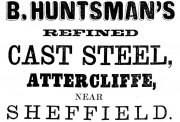B. Huntsman
of Attercliffe, nr Sheffield, "probably the oldest steel making firm in the world" (1903).
1742 Benjamin Huntsman, a clockmaker, moved from Doncaster to a cottage at Handsworth on the outskirts of Sheffield where he sought ways to improve the steels he needed for his clocks.
1750 The records of the Cutlers' Company of Hallamshire include a reference to Huntsman's steelmaking activities.
1751 After much development work, Benjamin Huntsman was able to produce his revolutionary crucible steel on a commercial scale.
During the early years of its manufacture, much of Huntsman's steel was exported to Europe as the local cutlers did not want to pay the high price of its quality. Many attempts were made at industrial espionage to learn his secrets.
By the 1760s his first serious rivals were operating furnaces in Sheffield.
1760s Huntsman supplied crucible steel, blister steel and other local products such as tools and plate to William Blakey, a toy maker in Paris [1]
1770/2 Moved to premises known later as Huntsman's Row. He set up purpose-built works at Attercliffe[2].
1776 Benjamin Huntsman died; the business was carried on by his son William Huntsman
c.1787 Thomas Asline funded the development of the Huntsman's business in crucible steel in return for a half-partnership as Huntsman and Asline[3].
1787 William built another cementation furnace, giving the company an independent supply of blister steel.
1797 William Huntsman (marks B. Huntsman), steel refiner, of Attercliffe[4].
1805 Another steel furnace was added.
William's son, Francis Huntsman, expanded the Attercliffe Steelworks further.
1825 Francis Huntsman, steel converter and refiner, of Attercliffe[5].
1826 By this time, Benjamin's original furnaces had been demolished; a second steelworks site, called the Weigh House Furnace had been established close to the Attercliffe works.
1829 Francis Huntsman, Attercliffe, Steel Converters and Refiners[6].
1840 Huntsmans acquired land adjacent to the new canal to construct a wharf, to save time and money on the storage and transportation of raw materials.
1841 Huntsman, Fras., steel converter & refiner, Attercliffe[7].
1842 A large 12-hole furnace was built at Attercliffe.
1846 B. Huntsman, steel converters and refiners, of Attercliffe, Sheffield [8]. Benjamin Huntsman, coal master(s) & dealers, Tinsley Coal Co. Office, Cattle Market, Sheffield [9].
1860 The new railway purchased and closed the wharf.
1862 Benjamin Huntsman and Co, colliery owners (Tinsley Coal Co) of Tinsley Park[10].
1867 Huntsman's steel still commanded premium prices e.g. for surgical knives in France, reflecting the fact that where labour was a prime consideration, it was acceptable to pay higher prices for the best steel[11].
1867 Benjamin Huntsman, Coal Owner, Tinsley Coal Co. and Steel (Sheffield) of Tinsley; living at West Retford Hall, Tinsley Township[12].
1879 On Francis' death, his only son Benjamin was in charge of the business, together with his son Francis[13].
1898 Trademark renewal for the B. HUNTSMAN mark, for Messrs Francis and Harry Fitzmaurice Huntsman trading as B. Huntsman for 14 years[14].
1899 Huntsmans finally left Huntsman's Row.
1901 Listed as B. Huntsman, Steel Manufacturer of Tinsley Park Road, Sheffield. Also Frank Huntsman and Harry Huntsman of the firm and of West Retford Hall. [15]. Registered corporate marks: B. Huntsman and Ajax[16].
1903 Mr B. Hunstman wrote to The Times pointing out that Ajax steels from his company and steels from Messrs Jonas and Colver were of comparable quality to those of Armstrong Whitworth for tool making[17].
1905 Listed as B. Huntsman, Steel Manufacturer of Tinsley Park Road, Sheffield. Also Frank Huntsman and Harry Huntsman of the firm and West Retford Hall. [18] (Established 1751) Inventor of Crucible Cast Steel & Manufacturer of Best Cast Steel for Tools of all Descriptions, of Tinsley Park Road[19].
1917 Dunford and Elliott was advertising its business at Attercliffe Wharf, Sheffield, suggesting an interest in B. Huntsman
1934 Records of the company still trading at this date held in Kelham Island Museum
1934 (in French) Renewal of B. HUNTSMAN trademark for 15 years[20].
1968 Listed as part of Dunford and Elliott [21]
1983 B. Huntsman Steel Mfrs, 9 Coleridge Rd, Sheffield[22]
See Also
Sources of Information
- ↑ Crucible steel as an enlightened material, by Chris Evans [1]
- ↑ The Times, 27 February, 1879
- ↑ The Times, 29 April 1942
- ↑ Robinson's Directory of Sheffield, 1797 [2]
- ↑ Gells 1825 Directory of Sheffield. [3]
- ↑ Pigot's Directory of Sheffield 1829 [4]
- ↑ Henry & Thos. Rodgers Sheff & Roth Directory - 1841. [5]
- ↑ Slaters 1846 Directory, Sheffield. [6]
- ↑ Slaters 1846 Directory, Sheffield. [7]
- ↑ Drake's Rotherham & District Directory - 1862. [8]
- ↑ The Sheffield & Rotherham Independent, 22 October 1867
- ↑ Whites Sheffield & District Directory - 1871. [9]
- ↑ The Times, 27 February 1879
- ↑ National Archives [10]
- ↑ 1901 White's Directory of Sheffield and Rotherham
- ↑ White's Directory of Sheffield & Rotherham, 1901
- ↑ The Times, 16 November 1903
- ↑ 1905 White's Directory of Sheffield and Rotherham
- ↑ Whites Directory of Sheffield & Rotherham. [11]
- ↑ National Archives [12]
- ↑ The Times, Friday, Jan 05, 1968
- ↑ BT phonebook





